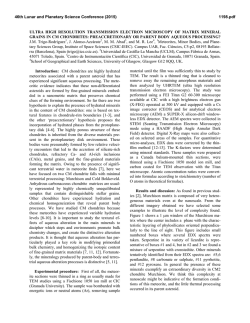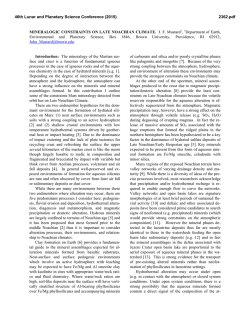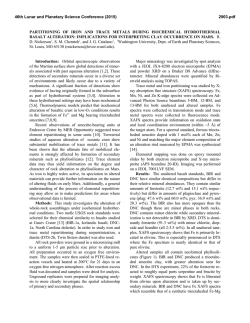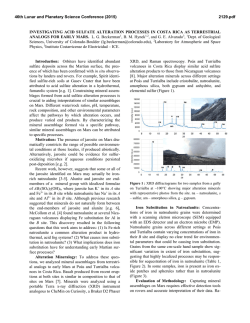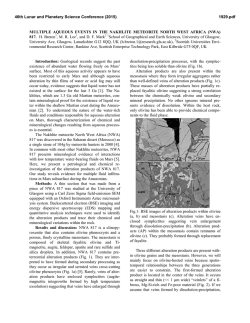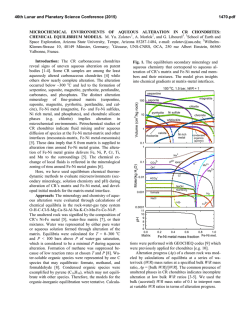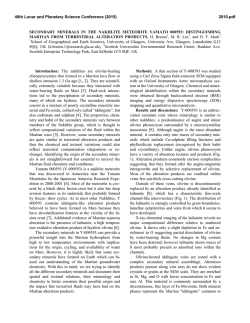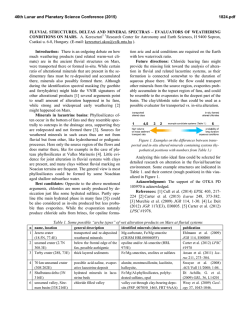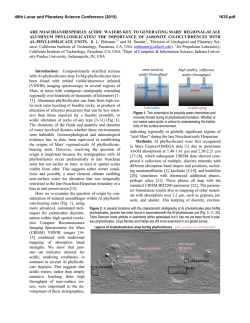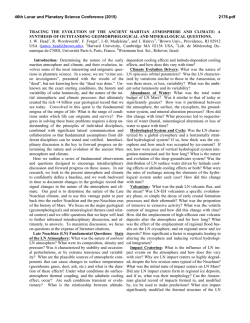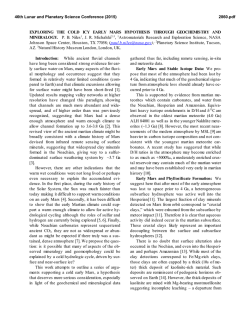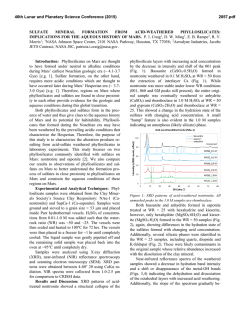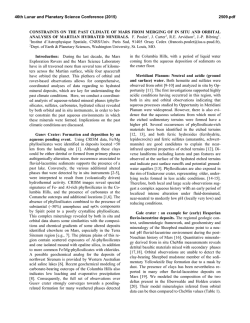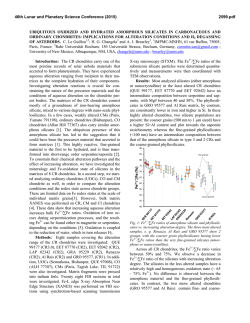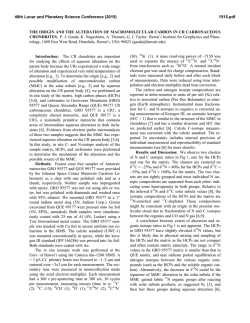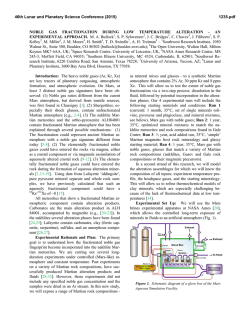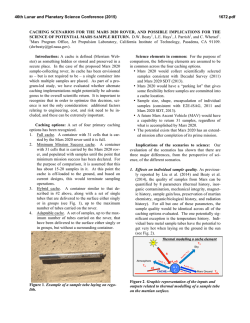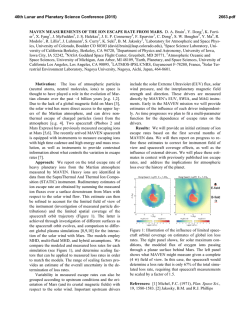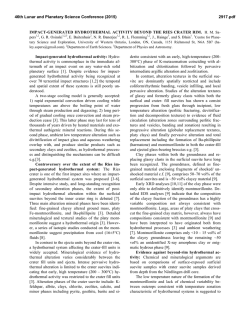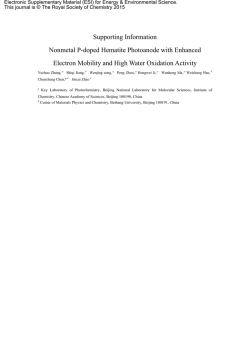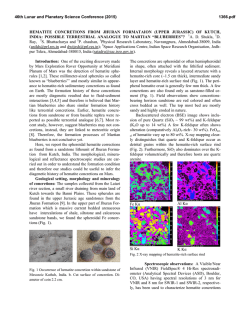
MINERALOGICAL INDICATORS FOR CLIMATE - USRA
46th Lunar and Planetary Science Conference (2015) 2582.pdf MINERALOGICAL INDICATORS FOR CLIMATE CHANGE ON MARS: EVIDENCE FROM LANDED MISSIONS. D. W. Ming1, R. V. Morris1, and B. C. Clark2, 1NASA Johnson Space Center, Mail Code XI, 2101 NASA Parkway, Houston, TX, 77058, USA, [email protected], 2Space Science Institute, 4750 Walnut, Boulder, CO 80301, USA. Introduction: Mineralogical and geochemical data returned by a flotilla of Mars orbiters and landers over the past 10 years has substantially enhanced our understanding on the evolution of the atmosphere and climate. Instruments onboard Mars Express and MRO discovered widespread deposits of phyllosilicates that formed during the Noachian followed by formation of sulfates into the Hesperian [1]. The formation of extensive valley networks along with these layered deposits of phyllosilicates and sulfates during the late Noachian/early Hesperian indicate a past martian climate that was capable of maintaining liquid water at the surface. The planet’s climate changed substantially after these early “episodes” of water and very little aqueous alteration has occurred over the past 3.5 Gyrs [1]. A key to understanding Mars past climate is to identify, characterize, and age date secondary minerals that have formed by reaction with volatile compounds, e.g., H2O, CO2, SO2. Here, we summarize the detection of secondary minerals at the four landing sites visited over the past 10 years. We also provide potential pathways for their formation and implications for past climate change on Mars. Secondary Minerals (landed missions): Secondary phases, proposed models for alteration, and relative estimated ages for key outcrops, soils, and rocks at the four landing sites are summarized in Table 1. Models for Aqueous Alteration: Our knowledge on the style and extent of aqueous alteration on Mars is based upon our understanding of terrestrial environments where these phases have formed. Next we describe candidate models for alteration based upon mineralogy/geochemistry obtained from landed missions. Isochemical vs. Open-System Alteration. Mars is a basaltic planet and the surface is dominated by basaltic chemical compositions. Weathering or the removal of soluble species from the reaction front is expected if water freely moved on the surface of Mars similar to the way it moves in open hydrologic systems on Earth. The geochemistry of most outcrops, rocks and soils analyzed by the APXS at the MER and MSL landing sites have not been extensively altered by open-system aqueous processes; i.e., they have not been extensively leached of mobile elements. Several exceptions include (1) high Al in Independence class rocks in the Columbia Hills, (2) high Si in Fuzzy Smith and Gertrude Weise class rocks and soils near Home Plate, (3) highAl in Esperance boxwork outcrop on the rim of En- Table 1. Aqueous alteration phases, proposed models for alteration, and relative age of key outcrops, rocks, and soils for Mars surface materials characterized by rovers and landers over the past 10 years [from 2-8]. Gusev crater1 West Spur rocks - goethite, hematite, np-Ox Paso Robles soils – ferric-sulfates, Mg- and Ca-sulfates (inferred), hematite, Ca-phosphates (inferred) Independence outcrop - phyllosilicates (implied) Comanche outcrop – Fe/Mgcarbonates, np-Ox, hematite Gertrude Weise soils - opaline silica Meridiani Planum1 Burns fm - jarosite, hematite, Caand Mg-sulfates (inferred) Endeavour crater rim rocks – phyllosilicates (inferred) Ca-sulfate veins Northern Arctic Soil (Phoenix)2 Ca/Mg-carbonates, perchlorate salts Gale crater3 Rocknest windblown deposit – Xray amorphous component, anhydrite, hematite (?) Sheepbed mudstone – Fe-saponite, X-ray amorphous component, magnetite, anhydrite, bassanite, akaganeite, hematite, akaganeite, pyrrhotite (?) Alteration Style Impact Age4 AcidSulfate N/H? Neutral pH N? Alkaline pH N? Acidic Bleaching N/H? Acid-sulfate H Neutral pH Acidic solutions? N H Alkaline pH thin films A Thin film, physical, thermal Neutral pH with subsequent diagenetic acidic A N? N/H 1Mössbauer spectrometer, inferred phases from APXS geochemistry; 2Mineralogy inferred from thermal evolved gas and wet chemistry analyses, 3CheMin analyses, 4A = Amazonian, H = Hesperian, N = Noachian; (?) – questionable phase formed via aqueous alteration or relative age. deavour crater, and 4) high Si, low Ca & Mg in the Pahrump Hills outcrop in Gale crater [9-10]. Al enrichments suggest that these materials have undergone weathering with leaching and may contain a smectite- 46th Lunar and Planetary Science Conference (2015) like phase or its compositional equivalent. High Si suggests leaching of basic cations in an open system, likely under acidic conditions. Acid-Sulfate Alteration. The high elemental abundance of S in surface materials is obvious evidence that sulfate-bearing solutions have played a major role in aqueous processes at all landing sites on Mars. The sulfate-rich outcrop at Meridiani Planum contains jarosite and Ca-Mg-sulfates and has an SO3 content of up to 25 wt.%. The interiors of rocks and outcrops on the Columbia Hills have up to 8 wt.% SO3. Soils at two MER landing sites generally have between 5 to 14 wt.% SO3 and one soil class (Paso Robles) contains around 30 wt.% SO3. After normalization of major element compositions to a SO3-free basis, the bulk compositions of these materials are basaltic. These observations suggest that the surface materials were derived from basaltic precursors by acid-sulfate alteration under nearly isochemical conditions and/or very low water:rock ratios with minimal leaching. Several hypotheses have been suggested for the aqueous formation of sulfate-bearing phases on the surface of Mars including (1) oxidative weathering of ultramafic igneous rocks containing sulfides; (2) sulfuric acid weathering of basaltic materials; (3) acid fog weathering of basaltic materials, and (4) near-neutral pH subsurface solutions rich in Fe2+ that were rapidly oxidized to Fe3+, which produced excess acidity as iron was oxidized on exposure to O2 or photo-oxidized by ultraviolet radiation at the martian surface [2,11]. Neutral and Alkaline pH Hydrolytic Alteration. Phyllosilicates are assumed to have formed under circum-nuetral to alkaline pH conditions on Mars based on our terrestrial experience. Smectite formation in the terrestrial environment requires aqueous environments where solutions have high Si and Mg activity and neutral to alkaline pH conditions [12]. Although smectite can form under low-temperatures, smectite formation in laboratory experiments has been most successful under hydrothermal conditions [12]. Fe- and Mg-rich smectite can form under strongly acidic (pH 3-4) hydrothermal closed-systems from Mars-like basaltic glass materials [13]. These secondary phases have formed under isochemical (“closed” system) aqueous conditions. Mars has very little evidence of opensystem alteration so an important future measurement is the chemistry of smectite-rich sedimentary deposits on the flanks of Mt. Sharp by Curiosity. Another potential aqueous process that may form smectite and other secondary phases under neutral or alkaline isochemical conditions is hydrothermal aqueous alteration associated with impact events [14-15]. Large impacts will generate a thermal pulse through the host material. Hydrothermal aqueous alteration can thus occur in these large 2582.pdf impact events if the host materials contain water and/or other volatile phases. Thin film alteration. Several models for thin alteration include acid fog alteration as described above and interactions of atmospheric gases in thin H2O films on particle surfaces. The later model was proposed for the formation of Ca-rich carbonates in the soils at the Phoenix landing site [4]. Subsurface ice and annual episodes of ice on the surface create high relative humid in the sediments between the two ice layers. Carbonate formed by the interaction of atmospheric CO2 with liquid water films on particle surfaces. This style of alteration is likely a recent process, again under isochemical aqueous alteration conditions with the exception of the addition of atmospheric CO2. Implications for Mars Climate Change: The occurrence of phyllosilicates suggests neutral to slightly alkaline hydrolytic conditions very early in the planet’s history and that the sulfates formed later under acidsulfate conditions during the Hesperian based on natural terrestrial occurrences for phyllosilicates and acid sulfates. However, Mars may not have undergone substantial periods of aqueous alteration that would reflect open-system hydrologic systems. The formation of phyllosilicates under isochemical, “closed” system acidic aqueous alteration conditions cannot be ruled out. Aqueous alteration appears to have occurred early in the planet’s history (3 to 4.5 billion years ago). While aqueous alteration may still be occurring at the surface today (e.g., thin films of water, acid fog, etc.), no evidence has yet been found of substantial alteration at the surface for the past 3 billion years. Hence, there is no doubt that the climate of Mars during the Noachian/Hesperian was capable of maintaining liquid water at or near the surface of Mars, however, the relatively few occurrences of open-system alteration suggests the activity of liquid water was brief or occurred in closed basin systems. References: [1] Bibring J.P. et al. (2006) Sci., 312, 400-404. [2] Ming D.W. et al. (2008) In J. F. Bell (ed), The Martian Surface, 519-540. [3] Squyres S.W. et al. (2012) Sci., 336, 570-576. [4] Boynton W.V. et al. (2009) Sci., 325, 61-64. [5] Hecht M.H. et al. (2009) Sci., 325, 64-67. [6] Bish D.L. et al. (2013) Sci., 341, DOI:10.1126/science. 1238932. [7] Vaniman D.T. et al. (2014) Sci., 343, DOI:10.1126/science.1243480 [8] Arvidson R.E. et al. (2014) Sci., 343, DOI: 10.1126/ science.1248097. [9] Yen A.S. et al. (2015) this volume. [9] McLennan et al. (2015) this volume. [10] Hurowitz J.A. et al. (2010) Nat. Geo, 3, 323-326; [11] Kloprogge J.T. et al (1999) Clays Clay Min, 47, 529554. [12] Peretyazkno T. et al. (2015) this volume. [13] Newsom (1980) [14] Morris R.V. et al. (1995) JGR, 100, 5319–5328.
© Copyright 2025
